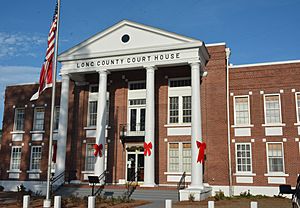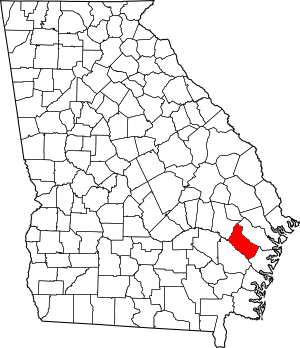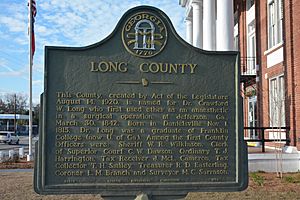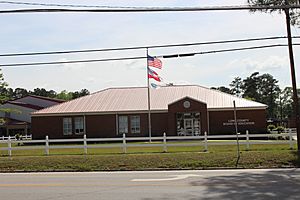Long County, Georgia facts for kids
Quick facts for kids
Long County
|
|
|---|---|

Long County Courthouse in Ludowici
|
|

Location within the U.S. state of Georgia
|
|
 Georgia's location within the U.S. |
|
| Country | |
| State | |
| Founded | November 2, 1920 |
| Seat | Ludowici |
| Largest city | Ludowici |
| Area | |
| • Total | 404 sq mi (1,050 km2) |
| • Land | 400 sq mi (1,000 km2) |
| • Water | 3.5 sq mi (9 km2) 0.9%% |
| Population
(2020)
|
|
| • Total | 16,168 |
| • Density | 40/sq mi (20/km2) |
| Time zone | UTC−5 (Eastern) |
| • Summer (DST) | UTC−4 (EDT) |
| Congressional district | 1st |
Long County is a county in the state of Georgia, in the United States. The main town and county seat (where the county government is) is Ludowici.
Long County is part of the Hinesville-Fort Stewart Metropolitan Statistical Area. This means it's connected to a larger area that includes the cities of Hinesville and Fort Stewart.
The county was officially created on November 2, 1920. It is named after Crawford Long, a doctor and pharmacist. He was famous for being the first person to use diethyl ether to make patients sleep during surgery.
In 2020, about 16,168 people lived in Long County.
Contents
About the Land
Long County covers a total area of about 404 square miles. Most of this area, about 400 square miles, is land. The remaining 3.5 square miles (less than 1%) is water.
Most of Long County is located in the Altamaha River area. Some parts in the northeast are in the Ogeechee River area.
Main Roads
Many important roads pass through Long County. These roads help people travel and connect different towns.
Neighboring Counties
Long County shares its borders with four other counties:
- Liberty County (to the northeast)
- McIntosh County (to the southeast)
- Wayne County (to the southwest)
- Tattnall County (to the northwest)
Towns and Communities
Long County has a few towns and smaller communities where people live.
Cities
- Ludowici (This is the main town and county seat.)
- Elim, Georgia
Other Communities
These are smaller areas that are not officially cities:
- Aimar
- Beards Creek
- Donald
- Tibet
Population Facts
| Historical population | |||
|---|---|---|---|
| Census | Pop. | %± | |
| 1930 | 4,180 | — | |
| 1940 | 4,086 | −2.2% | |
| 1950 | 3,598 | −11.9% | |
| 1960 | 3,874 | 7.7% | |
| 1970 | 3,746 | −3.3% | |
| 1980 | 4,524 | 20.8% | |
| 1990 | 6,202 | 37.1% | |
| 2000 | 10,304 | 66.1% | |
| 2010 | 14,464 | 40.4% | |
| 2020 | 16,168 | 11.8% | |
| 2023 (est.) | 19,594 | 35.5% | |
| U.S. Decennial Census 1790-1880 1890-1910 1920-1930 1930-1940 1940-1950 1960-1980 1980-2000 2010 |
|||
The population of Long County has changed over the years. In 1930, there were about 4,180 people. By 2020, the population had grown to 16,168 people.
People in Long County (2020)
Here's a look at the different groups of people living in Long County in 2020:
| Race | Number of People | Percentage |
|---|---|---|
| White (not Hispanic) | 8,774 | 54.27% |
| Black or African American (not Hispanic) | 4,028 | 24.91% |
| Native American | 62 | 0.38% |
| Asian | 164 | 1.01% |
| Pacific Islander | 88 | 0.54% |
| Other/Mixed | 1,073 | 6.64% |
| Hispanic or Latino | 1,979 | 12.24% |
In 2020, there were 16,168 people living in the county. These people made up 5,695 households, with 4,146 of those being families.
Schools and Learning
The Long County School System runs public schools for students from kindergarten to 12th grade. This includes elementary, middle, and high schools.
However, some parts of the county, especially around Fort Stewart, have different school arrangements. For elementary school students living on Fort Stewart, the Department of Defense Education Activity (DoDEA) operates their schools. Once these students reach middle and high school, they attend public schools run by the county school districts.
See also
 In Spanish: Condado de Long (Georgia) para niños
In Spanish: Condado de Long (Georgia) para niños



